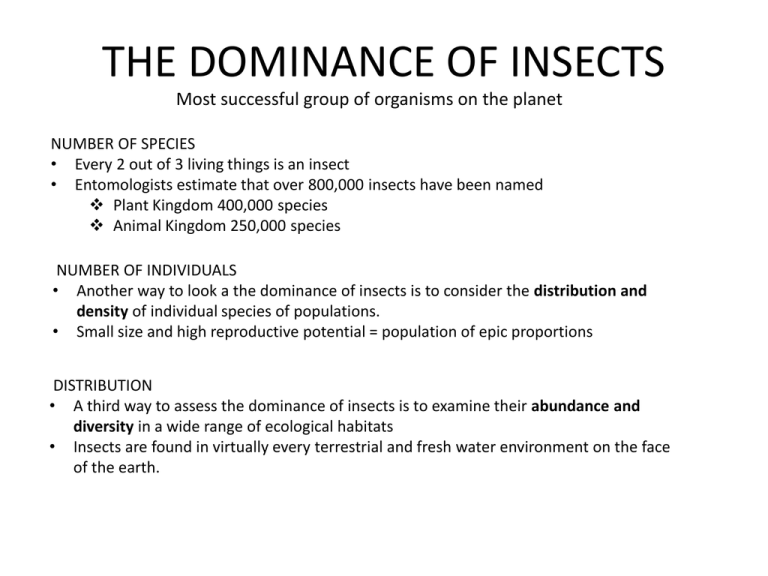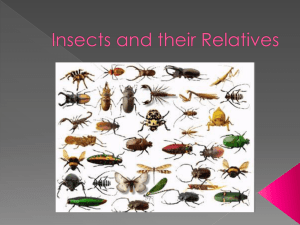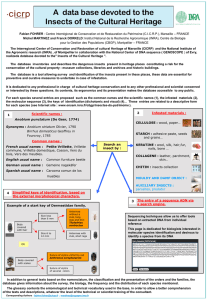
THE DOMINANCE OF INSECTS
Most successful group of organisms on the planet
NUMBER OF SPECIES
• Every 2 out of 3 living things is an insect
• Entomologists estimate that over 800,000 insects have been named
Plant Kingdom 400,000 species
Animal Kingdom 250,000 species
NUMBER OF INDIVIDUALS
• Another way to look a the dominance of insects is to consider the distribution and
density of individual species of populations.
• Small size and high reproductive potential = population of epic proportions
DISTRIBUTION
• A third way to assess the dominance of insects is to examine their abundance and
diversity in a wide range of ecological habitats
• Insects are found in virtually every terrestrial and fresh water environment on the face
of the earth.
• A single colony of Australian termites can
swell to several million individuals within an
earthen mound 20-25 feet tall
• A swam of migratory locusts may contain up
to 10 billion individuals, cover an area of
several thousand hectares, and have a total
biomass of over 30,000 metric tons
• Grape leafhoppers reach populations as dense
as 30 million hectare in some vineyards
IMPACT OF INSECTS
Economic impact
• Agriculture food and fiber production
• Health of humans and animals
Insects as food
• Represent an important food source for a wide variety of animal species
• Many cultures have relied on insects
Ecological impact
• As consumers, scavengers, and decomposers, insects play a vital role in the biogeochemical
cycling of nutrients
• As parasites and predators of other organisms, insects are part of a natural system of checks
and balances that strengthens community stability and prevents explosive population growth
from overrunning natural resources.
• Pollinators of angiosperms (flowering plants and trees)
Reasons for Success
Exoskeleton – an insects supporting skeleton is located on the outside of the its body
• Gives shape and support to the body’s soft tissue
• Provides protection from attack or injury
• Minimizes the loss of body fluids in both arid and freshwater environments
• Assures mechanical advantage to muscles for strength and agility in movement
• Can resist both physical and chemical attack
• Covered with an impervious layer of wax that prevents desiccation
Chitin- a polysaccharide that binds with various protein molecules to from a body wall that may
be as flexible and elastic as rubber or as hard and rigid as some metals.
Reasons for Success
Marvels of Miniaturization
• most species are of insects are between 2 and 200 mmm (0.1 -1.0 inch) in length
• Small size is optimal for exoskeleton
• Minimal resources are needed for survival and reproduction
• Ideal for avoiding predation
Flight
• Insects are the only invertebrates that can fly
• Highly effective mode of escape from predators
• Efficient means of transportation, allows populations to expand to new habitats and
resources
• Efficient use of energy allows some insects to travel great distances or remain airborne for
long periods of time.
Reasons for Success
Reproductive Potential
• Reproductive success is one of the most significant measures of an organisms’ fitness
• Females often produce large numbers of eggs (high fecundity), most of the eggs hatch (high
fertility), and the life cycle is relatively short (as little as 2-4 wks)
• Since most insects die nfore they ever have the oppurtunity to reproduce, a high
reproductive potential is the species’ best chance for survival
• Females can store the male’s genetic compliment for months or years in the spermatheca, a
special region of the reproductive system
• An unbalanced sex ratio, where females outnumber males and males can supply sperm for a
large number of females
• Many species of insects (aphids, scales, thrips, and midges) can reproduce without malesparthenogenesis
Reasons for Success
Metamorphosis
• most insects undergo significant developmental changes as they grow from immatures to
adults
• Incomplete metamorphosis changes occur gradually as the insect matures allowing
immatures and adults to line in similar habitats and feed on similar types of food.
• Complete metamorphosis a dramatic transformation in form and function between the
immature (larval) and adult stages of development
–
–
–
Larva is primarily adapted for feeding and growth. It builds energy reserves that in some cases will sustain the insect
for the rest of its life
An adult insect emerges and bears little to no resemblance to its larval form. Its primary function is dispersal and
reproduction
In the class Insecta, only 9 out of 28 orders undergo CM, yet those 9 orders represent about 86% if all insects alive
today
Reasons for Success
Adaptability
• A combination of large and diverse populations, high reproductive potential, and relatively
short life cycles, has equipped most insects with the genetic resources to adapt quickly in the
face of a changing environment.
• Adaptation is an ongoing process. Populations must continually change as new resources
appear and old one disappear.
Insects record of achievement is impressive. They were among the first creatures to:
• Invade the arid expanses of dry land and exploit green plants as a source of food
• The first animals to use flight as an escape from predators
• First organisms to develop a complex social hierarchy with division of labor and cooperative
care of the young.









